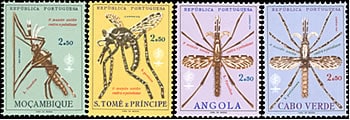At a glance
- The US eliminated malaria in the United States in the early 1950's.
- WHO certified the eradication of malaria from the U.S. in 1970.
- Over the past 50 years, small clusters of locally acquired mosquito-transmitted malaria have occurred in the continental U.S. among persons with no recent travel history to a malaria endemic country.
Impact
The U.S. Public Health Service (USPHS) and Malaria (1914-1942)
During the U.S. military occupation of Cuba and the construction of the Panama Canal at the turn of the 20th century, U.S. officials made great strides in the control of malaria and yellow fever. In 1914 Henry Rose Carter and Rudolph H. von Ezdorf of the USPHS requested and received funds from the U.S. Congress to control malaria in the United States. Various activities to investigate and combat malaria followed this initial request. As a result, the U.S. saw a reduction in malaria cases. USPHS established malaria control activities around military bases in the southern U.S. where malaria was widespread to allow soldiers to train year-round.
The U.S. Tennessee Valley Authority (TVA) – The Integration of Malaria Control with Economic Development (1933)
U.S. President Franklin D. Roosevelt signed a bill that created the TVA on May 18, 1933. The law gave the federal government a centralized body to control the Tennessee River's potential for hydroelectric power and improve the land and waterways for development of the region. An organized and effective malaria control program stemmed from this new authority in the Tennessee River valley. Malaria affected 30 percent of the population in the region when the TVA was incorporated in 1933. The Public Health Service played a vital role in the research and control operations and by 1947, the disease was essentially eliminated. Mosquito breeding sites were reduced by controlling water levels and insecticide applications.
Malaria Control in War Areas (MCWA) (1942-1945)
MCWA was established to control malaria around military training bases in the southern United States and its territories, where malaria was still problematic and had potential to threaten military recruits before heading off to war. Many of the bases were established in areas where mosquitoes were abundant and capable of spreading malaria from person-to-person. Eventually the MCWA also aimed to prevent reintroduction of malaria into the civilian population by mosquitoes that would have fed on returning malaria-infected soldiers. During these activities, MCWA worked extensively with state and local health department officials and trained staff on malaria control techniques and strategies.
CDC and Malaria (1946-present)
CDC's mission to combat malaria began at its inception on July 1, 1946. The Communicable Disease Center, as CDC was first known, stemmed from MCWA. Thus, much of the early work done by CDC was concentrated on the control and elimination of malaria in the United States. With the successful reduction of malaria in the United States, the CDC switched its malaria focus from elimination efforts to prevention, surveillance, and technical support both domestically and internationally. This is still the focus of CDC's malaria work today.

Elimination of Malaria in the United States (1947-1951)
The National Malaria Eradication Program was a cooperative undertaking by state and local health agencies of 13 southeastern states and the Communicable Disease Center of the U. S. Public Health Service, originally proposed by Dr. Louis Laval Williams. The program commenced operations on July 1, 1947. It consisted primarily of DDT application to the interior surfaces of rural homes or entire premises in counties where malaria was reported to have been prevalent in recent years. By the end of 1949, more than 4,650,000 houses were treated. It also included drainage, removal of mosquito breeding sites, and spraying (occasionally from aircrafts) of insecticides. In 1947, 15,000 malaria cases were reported. By 1950, only 2,000 cases were reported. By 1951, malaria was considered eliminated from the U.S.

The role of CDC became one of surveillance within the U. S. and of assistance in the world-wide efforts to eliminate or control malaria in the economically underdeveloped areas of the world.
Eradication Efforts Worldwide: Success and Failure (1955-1978)

With the success of DDT, the advent of less toxic, more effective synthetic antimalarials, and the enthusiastic and urgent belief that time and money were of the essence, the World Health Organization (WHO) submitted at the World Health Assembly in 1955 an ambitious proposal for the eradication of malaria worldwide. Eradication efforts began and focused on house spraying with residual insecticides, antimalarial drug treatment, and surveillance, and would be carried out in four successive steps: preparation, attack, consolidation, and maintenance. Successes included elimination in nations with temperate climates and seasonal malaria transmission. Some countries such as India and Sri Lanka had sharp reductions in the number of cases, followed by increases to substantial levels after efforts ceased. Other nations had negligible progress (such as Indonesia, Afghanistan, Haiti, and Nicaragua). Some nations were excluded completely from the eradication campaign (most of sub-Saharan Africa). The emergence of drug resistance, widespread resistance to available insecticides, wars and massive population movements, difficulties in obtaining sustained funding from donor countries, and lack of community participation made the long-term maintenance of the effort untenable. Completion of the eradication campaign was eventually abandoned. The goal of most current National Malaria Prevention and Control Programs and most malaria activities conducted in endemic countries is to reduce the number of malaria-related cases and deaths. To reduce malaria transmission to a level where it is no longer a public health problem is the goal of what is called malaria "control."
Recent increases in resources, political will, and commitment have led again to discussion of the possibility of malaria elimination and, ultimately, eradication.
